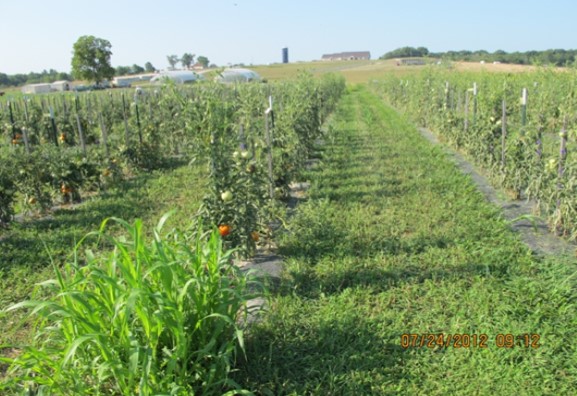Taking an environmentally sensitive approach to pest management
Cover Crops are Soil Health
Published: February 1, 2014
Like many other pairings in life (cookies and milk, table and chair) cover crops and soil health can exist independently, but they are at their best when working together. Thanks to Universities, seed companies and satisfied farmers, most vegetable growers in Missouri now have some knowledge of cover crops. In the following article, we won’t focus on the all the benefits or varie-ties of cover crops, but zoom in on just a few that are easy to use, highly versatile, and very effective at increasing soil health throughout the growing season and beyond. Among other im-portant roles, cover crops in-crease soil health through pre-venting erosion, scavenging nutri-ents, adding organic matter, re-lieving compaction and suppress-ing harmful nematodes. Focus here is on spring and summer cov-er crops.
Spring is one of the most challenging seasons to get a plant-ing established, especially for those of us with heavy, poorly drained soils, but options do exist. Frost seeding small seeded cover crops can be done anytime from now until late March. For those of you not familiar with this practice, frost seeding is basically broadcasting a small seed into a field that was tilled in the fall or that had the previous crop frost killed. The tiny seeds then work their way into the soil during the contraction and expansion of soil as it thaws and refreezes as well as with early spring rains. Traditionally, farmers have frost seeded legumes into existing pastures, but this prac-tice is just as applicable for vege-table growers that would like to get an early cover crop in before late planted winter squash or pumpkins. Clovers are the tradi-tional pick for frost seeding, but other small seeded, cool season crops-- such as turnips-- can work. Having an early spring cover crop will prevent those March and April rains from leeching all of your hard earned nitrogen into the nearest pond, ditch or stream.
Summer is prime cash crop time, and it can be hard to find the occasion or the energy to get a cover crop established, but it is well worth the effort!
Summer cover crop mixtures such as sorghum X sudangrass and cowpeas can pack on several tons per acre of biomass, while relieving compaction, suppressing weeds and providing forage for livestock. Both sorghum x sudan and cowpeas are easy to establish, and they thrive during the dog days of summer.

Sorghum X Sudangrass between rows of tomatoes at Lin-coln University, mowed every week or two.
Cow peas provide nitrogen to the soil and break down quickly when incorporated. Sorghum x Sudan grass can even be mowed reg-ularly and maintained as a turf between rows of tomatoes or hayed once, then left to grow tall and provide organic matter to the soil. The vast fibrous root system of sorghum x sudan even relieves com-paction, especially if mowed once or twice during the season (this stimulates root growth). There is even a summer cover crop that will mature in 30 days if you have minimal time in your rotation. Buck-wheat is easy to establish, super fast maturing and when seeded thickly it will smother out weeds. Buckwheat residue is also quick to break down so it is easily incorporated into the soil.
So as you are browsing seed catalogs and longing for the warm sunny days of spring, remember cover crops are soil health, and to be productive the soil needs to be healthy in all four seasons.
| Name | Season | Seeding Rate lb/A Drilled/Broadcast |
Benefits |
|---|---|---|---|
| Medium Red Clover | Spring/Summer | 8-10/10-12 | Adds N, conditions soil |
| Sorghum X Sudangrass (sudex, Sorgho, sorghum x Sudanese) | Summer | 35/40-50 | Suppress weeds, lots of biomass, breaks up compaction |
| Cowpeas | Summer | 30-90/70-120 | Adds N, suppress weeds |
| Radish (Oilseed, Tillage Graza Groundhog) | Fall | 8-13/10-20 | Breaks up compaction |
| Winter Rye (cereal, rye, rye grain) | Winter | 60-120/90-160 | Suppress weeds, lots of biomass |
| Hairy Vetch | Winter | 15-20/25-40 | Adds N, suppress weeds |
| Buckwheat | Summer | 48-70/50-90 | Smother crop, fast growing, breaks down quickly |
Seeding rates and times for several cover crops that are compatible with vegetable production. The Seeding rates are taken from: Managing Cover Crops Profitably 3rd Edition, SARE
Subscribe to receive similar articles sent directly to your inbox!
- Cover Crops for Vegetable Production (02/15/21)
- Cover Crops and Pollinators (11/30/16)
- Soil health under study in Missouri (11/18/16)
REVISED: November 20, 2015